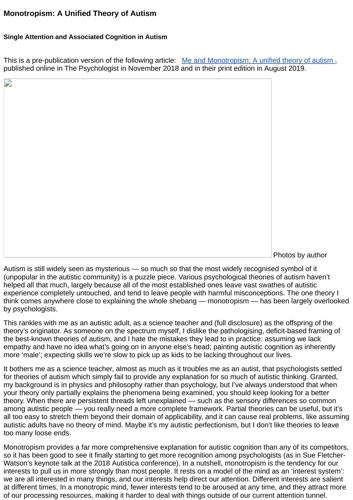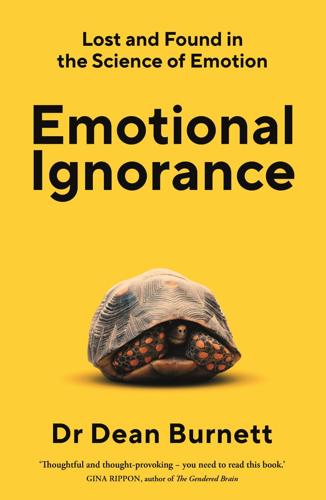double empathy problem
description: the mutual misunderstanding that occurs between people of different dispositional outlooks or cultural backgrounds
3 results

Monotropism: A Unified Theory of Autism
by
Unknown
Lawson, W. (2011). The passionate mind: How individuals with autism learn . Jessica Kingsley Publishers. McDonnell, A., & Milton, D. (2014). Going with the flow: reconsidering ‘repetitive behaviour’ through the concept of ‘flow states’. Milton, D. E. (2012). On the ontological status of autism: the ‘double empathy problem’. Disability & Society , 27 (6), 883–887. Murray, D., Lesser, M., & Lawson, W. (2005). Attention, monotropism and the diagnostic criteria for autism. Autism , 9 (2), 139–156. Murray D. (2018) Monotropism – An Interest Based Account of Autism. In: Volkmar F. (eds) Encyclopedia of Autism Spectrum Disorders.

Emotional Ignorance: Lost and Found in the Science of Emotion
by
Dean Burnett
Published 10 Jan 2023
But because people vary so much, this can mean we don’t empathise correctly. Given how empathy underpins a great deal of interpersonal interaction, this can be a problem. If you’re not empathising with someone correctly, it’ll hamper your ability to connect and communicate. A striking example of this is the ‘double empathy’ problem, which can happen when an autistic person interacts with a neurotypical individual.96 Here, the differing workings of autistic and neurotypical brains can mean that the experiences each person has, and the resulting memories obtained via them, aren’t particularly helpful for interpreting the emotional cues produced by the other.
…
It’s as if each is displaying their emotions in a language that the other person is still learning. Nobody is doing anything wrong, but both brains involved in the interaction are perhaps too heavily reliant on personal, subjective experiences to make sense of what the other one is doing. Hence, the double empathy problem. And this leads to one final, somewhat unsettling issue. Even if we leave aside our own emotions, the wider situation, and our flawed cognitive assessments, there can be a simpler explanation for why we fail to feel empathy for someone. Whether you call it prejudice or fear of the unknown, there are times we simply don’t want to empathise with someone.
…
Cummings, ‘Relationships between dimensions of attachment and empathy’, North American Journal of Psychology, 2002, 4(1): pp. 63–80. 95 Hall, J.A. and S.E. Taylor, ‘When love is blind: maintaining idealized images of one’s spouse’, Human Relations, 1976, 29(8): pp. 751–761. 96 Milton, D.E., ‘On the ontological status of autism: the “double empathy problem”’, Disability & Society, 2012, 27(6): pp. 883–887. 97 De Waal, ‘Putting the altruism back into altruism’. 98 Cikara, M., et al., ‘Their pain gives us pleasure: how intergroup dynamics shape empathic failures and counter-empathic responses’, Journal of Experimental Social Psychology, 2014, 55: pp. 110–125. 99 Cikara, M., E.G.

Neurodiversity at Work: Drive Innovation, Performance and Productivity With a Neurodiverse Workforce
by
Amanda Kirby
and
Theo Smith
Published 2 Aug 2021
Ensure line managers have training so they are confident to have conversations. Demonstrate you care and you are interested in attracting a neurodiverse range of skills and talents. Ensure your website is accessible and your application forms are too. Notes 1 Milton, D (2012) On the ontological status of autism: the ‘double empathy problem’, Disability & Society, https://kar.kent.ac.uk/62639/ (archived at https://perma.cc/M6AX-GLNE) 2 Elder Robison, J (2007) Look Me in the Eye: My life with Asperger’s, Crown, New York 3 Elsbach, K D (2003) How to pitch a brilliant idea, Harvard Business Review, https://escholarship.org/uc/item/1w82h22c (archived at https://perma.cc/PL2Y-TVGT) Further reading Milton, D (2017) A Mismatch of Salience, Pavilion, https://www.pavpub.com/a-mismatch-of-salience/ (archived at https://perma.cc/P7W7-ETDG) 08 Apprenticeships, internships, work placements and hiring schemes Introduction The value of work-based learning and training is something that cannot be disputed.